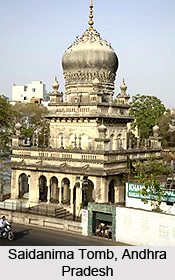Tomb of Adham Khan
Adham Khan's Tomb was erected in the year 1561 and is preserved by the Archaeological Survey of India. Adham Khan, Akbar's general was buried in this structure and is situated in Mehrauli in Delhi, particularly in the northern section of the Qutub Minar. Khan was his wet nurse Maham Anga's son.
Hazira Maqbara Tomb
Graves of the teacher of Salim who was Akbar's successor and also grave of Naurang Khan, another son of Akbar are present in the Hazira Maqbara Tomb which had been created in 1586. Its architecture follows the typical Mughal architectural characteristics.
 Tomb of Mariam-uz-Zamani
Tomb of Mariam-uz-Zamani
Mariam-uz-Zamani or Heer Kunwari, also known as Jodha Bai was the Rajput wife of Akbar who was buried in the Tomb of Mariam-uz-Zamani. It was established between 1623 and 1627 CE. It is present at Sikandra, near Agra, Uttar Pradesh.
Tomb of Itimad-ud-Daulah
Tomb of Itimad-ud-Daulah is based in Agra, Uttar Pradesh and was constructed in the period between 1622 and 1628. Exquisite marble ornamentation, along with red sandstone was utilized to beautify the tomb and later white marble and pietra dura were applied.
Adham Khan's Tomb was erected in the year 1561 and is preserved by the Archaeological Survey of India. Adham Khan, Akbar's general was buried in this structure and is situated in Mehrauli in Delhi, particularly in the northern section of the Qutub Minar. Khan was his wet nurse Maham Anga's son.
Hazira Maqbara Tomb
Graves of the teacher of Salim who was Akbar's successor and also grave of Naurang Khan, another son of Akbar are present in the Hazira Maqbara Tomb which had been created in 1586. Its architecture follows the typical Mughal architectural characteristics.
 Tomb of Mariam-uz-Zamani
Tomb of Mariam-uz-ZamaniMariam-uz-Zamani or Heer Kunwari, also known as Jodha Bai was the Rajput wife of Akbar who was buried in the Tomb of Mariam-uz-Zamani. It was established between 1623 and 1627 CE. It is present at Sikandra, near Agra, Uttar Pradesh.
Tomb of Itimad-ud-Daulah
Tomb of Itimad-ud-Daulah is based in Agra, Uttar Pradesh and was constructed in the period between 1622 and 1628. Exquisite marble ornamentation, along with red sandstone was utilized to beautify the tomb and later white marble and pietra dura were applied.
For more read:
